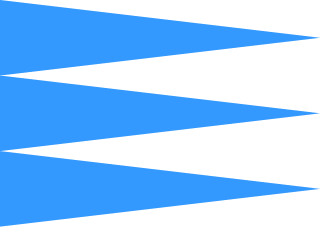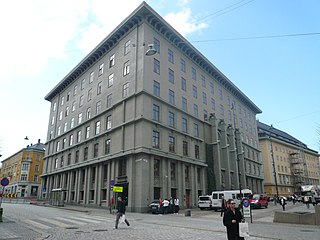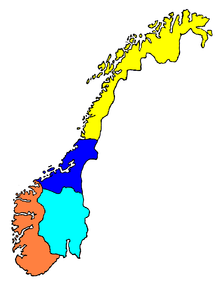
Selje (municipality) was a municipality in the old Sogn og Fjordane county, Norway and was located in the traditional district of Nordfjord. The village of Selje was the administrative center this municipality. On 1 January 2020 the municipality became part of the new Stad Municipality in the newly formed Vestland county.

Norway is divided into 11 administrative regions, called counties which until 1918 were known as amter. The counties form the first-level administrative divisions of Norway and are further subdivided into 356 municipalities. The island territories of Svalbard and Jan Mayen are outside the county division and ruled directly at the national level. The capital Oslo is both a county and a municipality.
Norwegian Postal Codes are four-digit codes, known in Norwegian as postnummer. Posten, the Norwegian postal service, makes small modifications to the postal code system each year. In 1999 Posten made considerable changes to the postal codes in Norway.

Norwegian dialects (dialekter) are commonly divided into four main groups, 'Northern Norwegian', 'Central Norwegian' (trøndersk), 'Western Norwegian' (vestlandsk), and 'Eastern Norwegian'. Sometimes 'Midland Norwegian' and/or 'South Norwegian' are considered fifth or sixth groups.

Hallingdal is a valley as well as a traditional district located in the traditional and electoral district Buskerud in Viken county in Norway. It consists of six municipalities: Flå, Nes, Gol, Hemsedal, Ål and Hol.
Bergensk or Bergen dialect is a dialect of Norwegian used in Bergen, Norway. It is easy for Norwegians to recognise, as it is more distinguishable from other dialects in Vestland than, for example, the Stavanger dialect (Stavangersk) from the dialects of Rogaland, and the Trondheim dialect from Trøndelag dialects.
The Norwegian Christian Student and School Association, is a Christian youth organization in Norway. Members refer to NKSS as "The team".

Gulating was one of the first Norwegian legislative assemblies, or things, and also the name of a present-day law court of western Norway. The practice of periodic regional assemblies predates recorded history, and was firmly established at the time of the unification of Norway into a single kingdom (900–1030). These assemblies or lagþings were not democratic, but did not merely serve elites either. They functioned as judicial and legislative bodies, resolving disputes and establishing laws.

Most of the Norwegian counties and municipalities have their own flag. They are based on the respective coat of arms of the subdivision. However they are seldom used. Most public buildings and private homes use the National flag. Note: As of 2020, many municipalities and counties have been merged. Because of this many of the new regions do not have a current flag and instead the coat of arms will be used for the new regions until a flag is made.
Hans Andreas Tanberg Gløersen was a Norwegian forest manager.

Jens Stub was a Norwegian priest and politician. He was vicar on the island of Veøya and served as a representative at the Norwegian Constitutional Assembly at Eidsvoll in 1814.
Ragnar Leif Ulstein MM was a Norwegian journalist, writer and resistance member. He wrote several documentary books from the Second World War, including surveys of the SOE group Norwegian Independent Company 1, volunteers sailing from Norway to Scotland, refugee traffic from Norway to Sweden, and military intelligence in Norway.

Nordhordland District Court was a district court in Norway serving the Nordhordland and Midhordland in Hordaland county, as well as Gulen Municipality in Sogn og Fjordane county. The court served the municipalities of Askøy, Austevoll, Austrheim, Fedje, Fjell, Fusa, Gulen, Lindås, Masfjorden, Meland, Modalen, Os, Osterøy, Radøy, Samnanger, Sund, Vaksdal, Voss, and Øygarden. The court was subordinate to the Gulating Court of Appeal. The court was led by the chief judge. The Nordhordland District Court was co-located with the Bergen District Court at the Bergen Tinghus at Tårnplads 2 in Bergen.
The Norwegian Correctional Service is a government agency responsible for the implementation of detention and punishment in a way that is reassuring for the society and for preventing crimes. The agency is governed by the Norwegian Ministry of Justice and Public Security.
Hans Hansen Lilienskiold was a Norwegian jurist, government official, civil servant and land owner. He was a member of the Lilienskiold noble family and served as County Governor of Finnmark. He is particularly remembered as an author for his works on the topography and culture of Finnmark.

The Norwegian Bible Belt is a loosely defined southwestern coastal area of Norway, which is more religiously observant than most of the rest of the country. Typically, the definition covers Western Norway (Vestlandet) and Southern Norway (Sørlandet), which includes the counties of Rogaland, Hordaland, Sogn og Fjordane, Møre og Romsdal, Vest-Agder and Aust-Agder. However, the most urban areas, such as Stavanger, have become strongly secularised since the 1960s and are no longer considered part of the Bible Belt.

Vestland is a county in Norway established on 1 January 2020. The county is located in Western Norway and it is centred around the city of Bergen, Norway's second largest city. The administrative centre of the county is the city of Bergen, where the executive and political leadership is based, but the County Governor is based in Hermansverk. The county is one of two counties in Norway that have Nynorsk as their official written language form.










